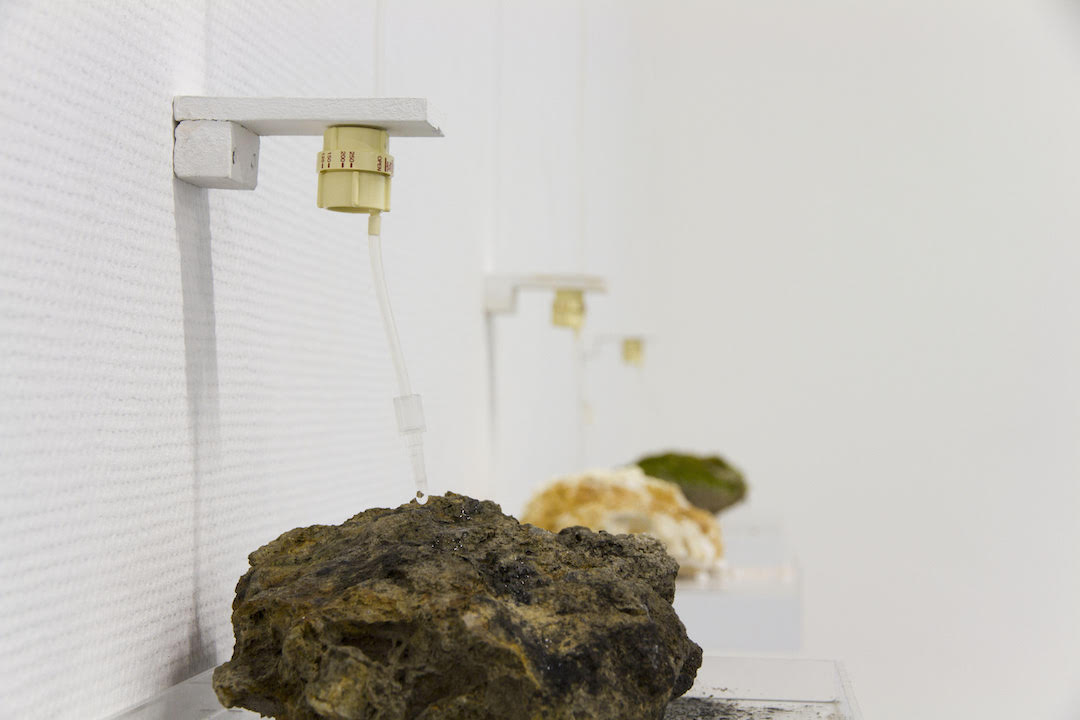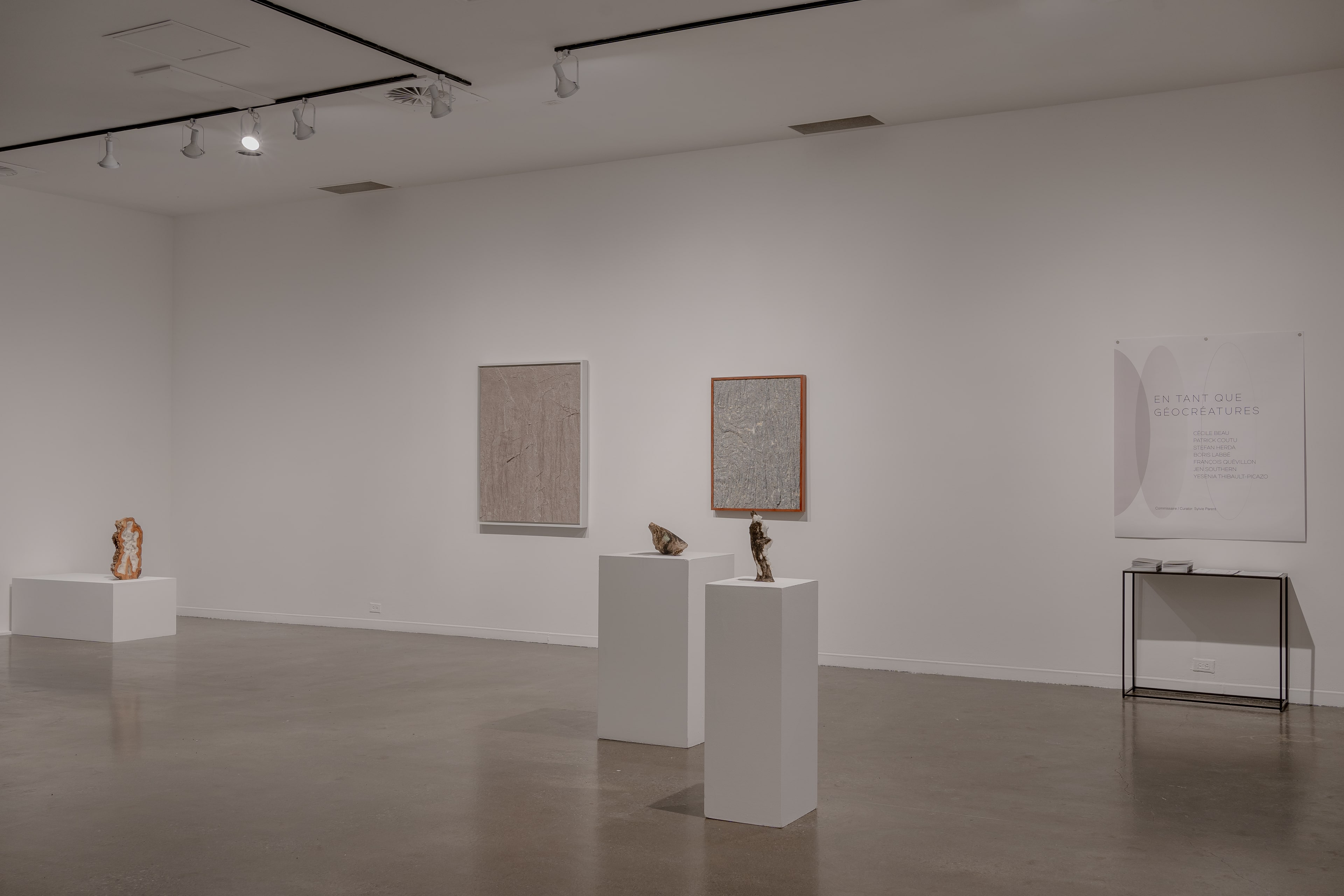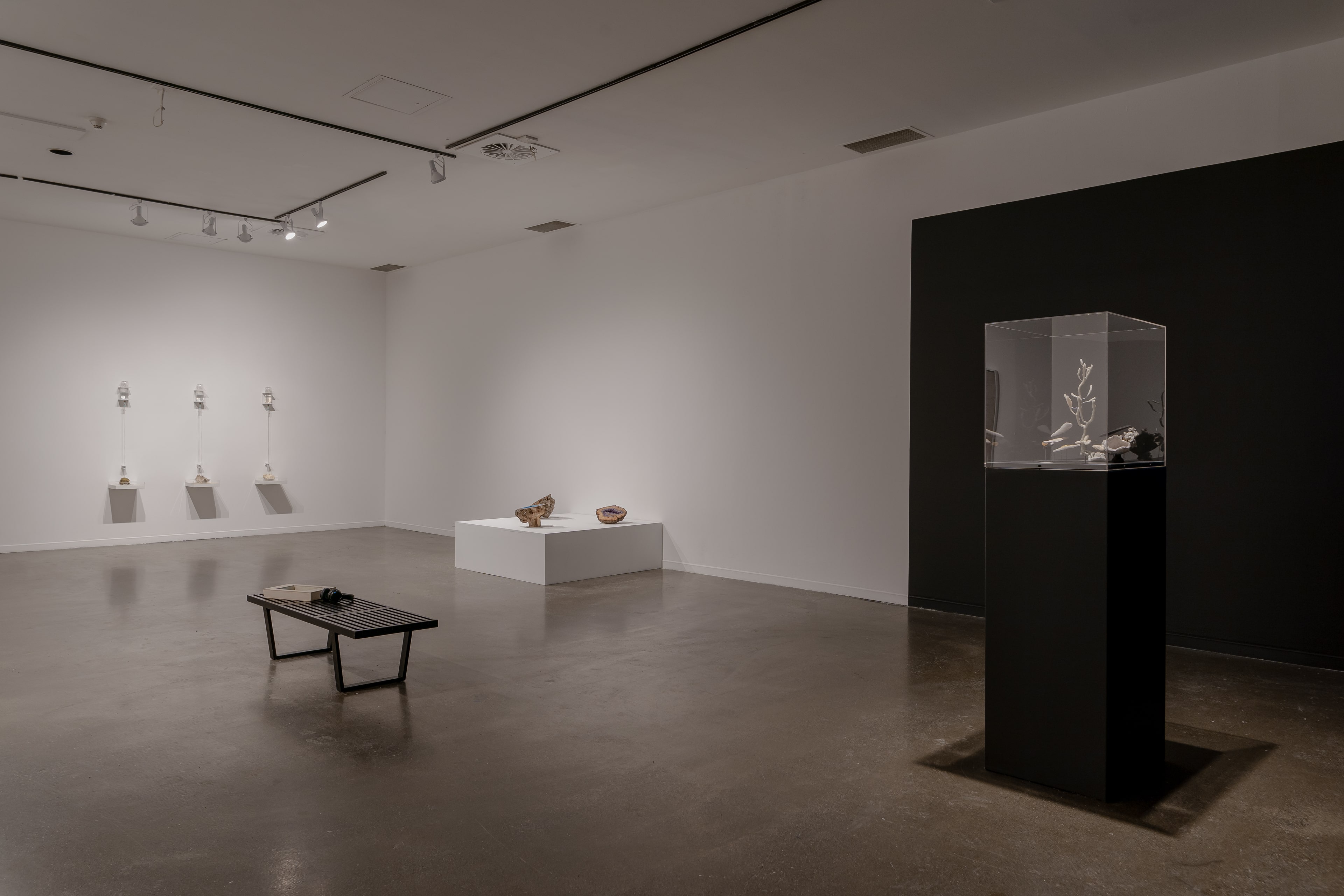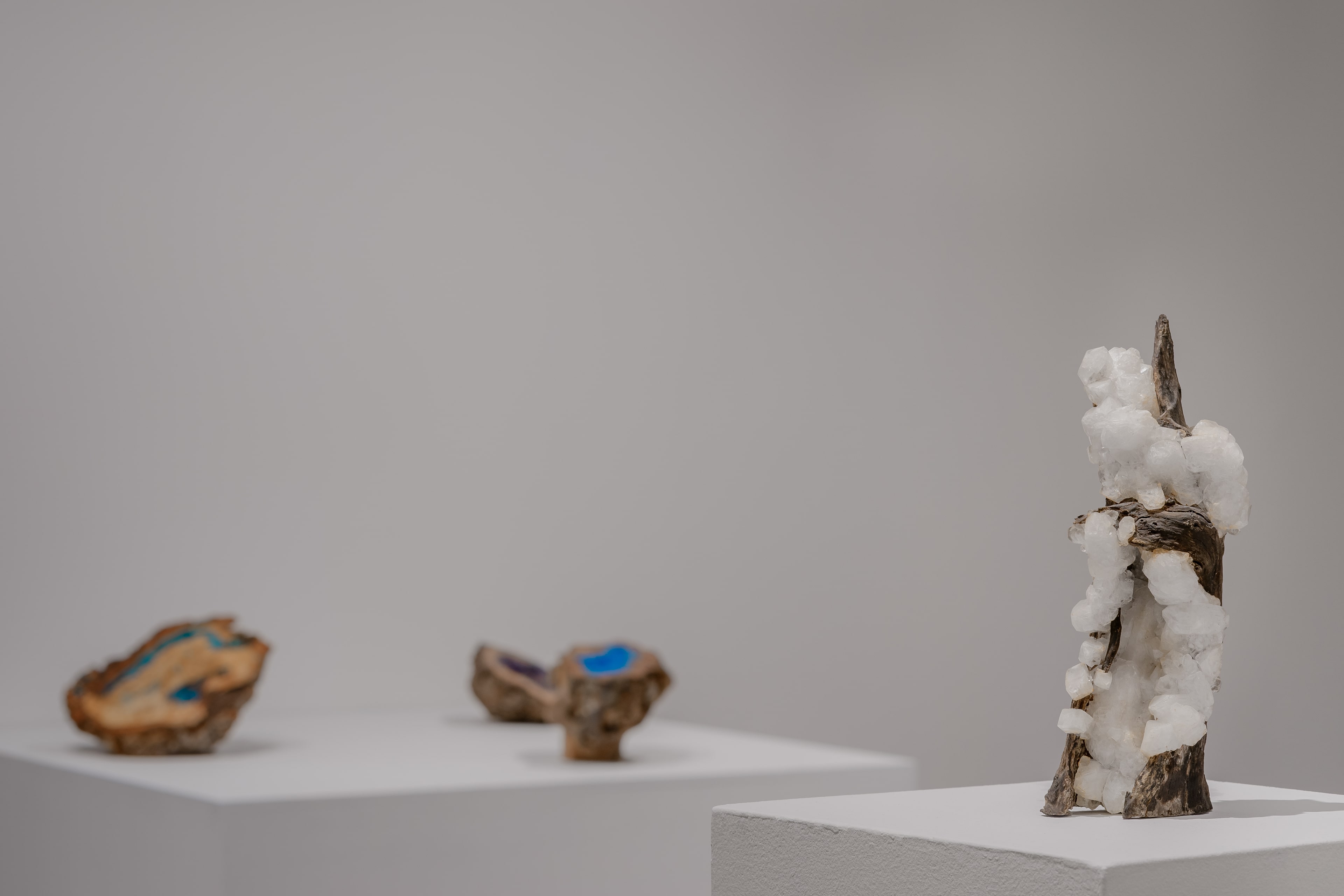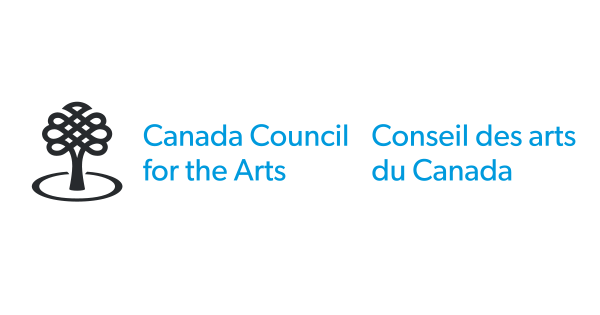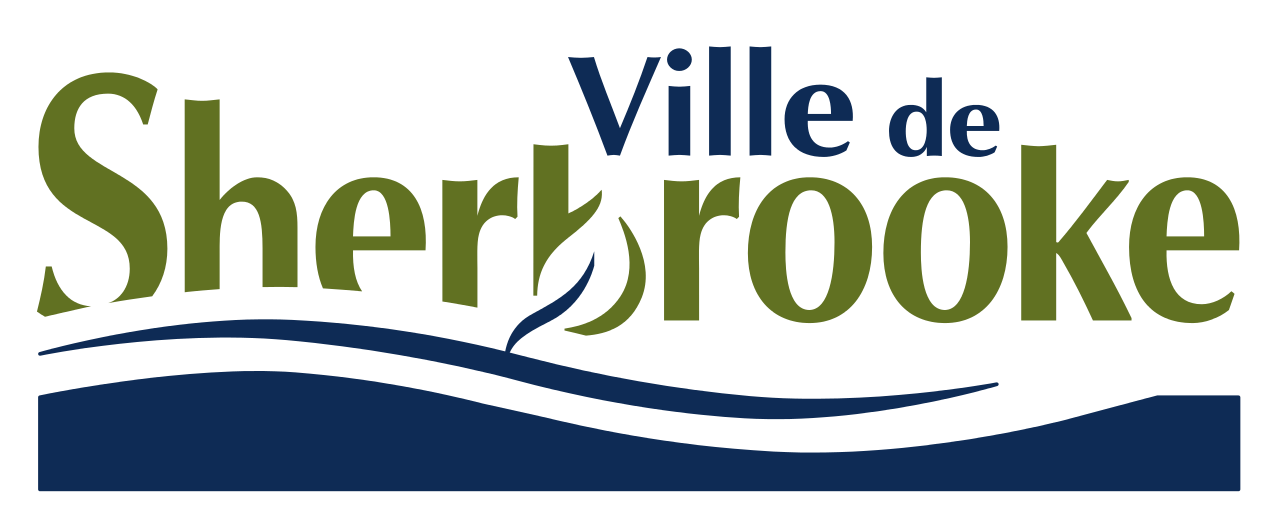SOCIAL CURRENTS
As Geocreatures
January 18 – March 23, 2024
Artists
Cécile Beau, Patrick Coutu, Stefan Herda, Boris Labbé, François Quévillon, Jen Southern, Yesenia Thibault-Picazo
Curator
Sylvie Parent
Overview
As Geocreatures brings together artistic projects that, in their evocation, reinvention and updating of the connections between living matter and the mineral, invite us to see life through the lens of geology and contemplate how evolution has affected our planet.
As the earth sciences teach us, geological processes provided the landforms and matter favourable to the emergence of life. But living things, too, have played a role in shaping the earth’s crust through such processes as fossilization, bioerosion or organic sedimentation. Indeed, the reciprocal exchange between the living and the mineral points to a shared occupancy of the planet and an ongoing co-evolution. Quite simply, the biosphere cannot be envisaged without the geosphere, and vice versa.
Philosopher Jane Bennett sees us as “geo-creatures” who, composed of the same chemical elements as the earth, are deeply engaged in its transformation. From our remote mineral origins to the remnants of our civilizations that are destined to end up encased in rock, we are geology. In navigating the space between geosphere and biosphere, between the mineral and the living, we can begin to grasp our connection to the planet and draw on our strength, as geocreatures, to face the coming times.
Artists
Through sculptures and sound & light installations, Cécile Beau constructs minimal, sensory works that make nature the object of study and contemplation. The artist combines plants and minerals with various technologies to recreate specific physical phenomena. Currently living and working in Paris, she graduated from the École Supérieure des Beaux-Arts in Tarbes in 2001, Les Beaux-Arts de Marseille in 2003 and Le Fresnoy National Studio for Contemporary Arts in Tourcoing in 2008. Winner of the 2011 Prix Découverte, an annual award granted by the Amis du Palais de Tokyo, she has had a number of solo and group shows to date in addition to being part of numerous artist residencies in France and abroad (Argentina, Germany, Belgium, China, Colombia, India, Poland, Switzerland, Czechia).
As a sculptor, Patrick Coutu works in both two and three dimensions. Inspired by scientific research, his work questions the processes at the basis of natural structures. Recent years have seen him turn his focus to mathematical models amongst other things, in a quest to explain the development of natural structures by translating the models into physical form. His work can be found in a number of private, institutional and museum collections, including the National Gallery of Canada, the Musée d’art contemporain de Montréal (MACM) and the Musée national des beaux-arts du Québec (MNBAQ). In 2016, he unveiled a permanent work, Le jardin du sculpteur, on the Parizeau terrace of the MNBAQ’s new Pierre Lassonde wing. In 2019, the Musée de Joliette curated a selection his works in a show entitled L’attraction du paysage. The artist is represented by Galerie Blouin Division in Montreal.
Stefan Herda examines our relationships within the natural world through drawing, sculpture and video. Inspired by the Earth sciences, his material and process-based research merges disparate elements: authenticity, facade, the natural and manufactured. Stefan Herda received his BAH from the University of Guelph in 2010 and a Master’s in Landscape Architecture from the University of Toronto in 2022. His work has been included in exhibitions nationally and featured in CBC Arts and Daily VICE. In recent years, he has exhibited work at Patel Brown Galleries and participated in Cultivars (Possible Worlds) at InterAccess in Toronto. Originally from Scarborough, Ontario, Stefan currently lives and works in Brooklyn, NY.
The work of illustrator and experimental filmmaker Boris Labbé is mainly in the form of short films, audiovisual concerts and video installations. Loops, repetition, representation, collage, patterns, metamorphoses and perpetual movement, interspersed with constant references to art history, literature and philosophy: these are the key elements of his audiovisual language, often described as a “cinema of multiplicities.” Labbé has exhibited in France and abroad (Japan, the United States, Canada, Spain, Croatia), screened at more than 300 international film festivals (including Cannes, Clermont-Ferrand, Annecy , Ottawa, Toronto and Hiroshima), aired on television and performed at various audiovisual concerts. His films and video installations have earned him some 50 awards and distinctions internationally, including the Golden Nica (Animation) at Ars Electronica in Linz and the Grand Prize at the Japan Media Arts Festival in Tokyo.
Interdisciplinary artist François Quévillon examines the interactions among environmental changes, societal issues and technological developments. He explores phenomena of the world and perception by implementing processes sensitive to environmental fluctuations and human interference. Frequently developed during artist residencies involving field research, his work has been presented at exhibitions and events held around the world over the last two decades. Among them : Connecting the Dots (Mexico), Sundance’s New Frontier exhibition (Park City), Spaces Under Scrutiny at the Knockdown Center (New York), International Symposium on Electronic Art (Gwangju, Dubai and Albuquerque), Flora and İnsan Eli Değmiş at Kalyon Kültür (Istanbul), .dreams at the Theatre of Digital Art (Dubai), Open Media Art Festival (Seoul), Festival Internacional de Linguagem Eletrônica (São Paulo), Mirage Festival (Lyon), Mois Multi (Québec), Espace [IM] Média (Sherbrooke), FIFA, Mutek, NeurIPS, RIDM, Elektra and International Digital Art Biennal (Montréal).
Jen Southern is an artist, senior lecturer in Fine Arts and New Media, and co-Director at the Centre for Mobilities Research at Lancaster University. With an ethos of shared authorship she collaborates with artists, technologists and members of the public to produce live installations that combine material and digital experience. A hybrid of art practice and mobilities research, her work has been exhibited internationally for over 25 years, including in Australia, Canada, Europe, Japan, Mexico, New Zealand and the United States. She curated exhibitions at the Global Mobility Futures (2013) Mobile Utopia: Pasts, Presents, Futures (2018) and Mobilities, Aesthetics and Ethics (2023) conferences. She works with Rebecca Birch and Sarah Casey as the artists collective Rocky Climates.
Yesenia Thibault-Picazo is a interdisciplinary designer and sound artist exploring the narrative potential of materials. She is interested in exploring a practice that bridges between research and design industry through long term projects and collaborations with experts in the field of art, crafts, natural and social sciences. In 2012, she initiated the research-based project “Craft in the Anthropocene”: a material investigation that forecasts the future of geology, explores speculative narratives, and interrogates our evolving relationship with nature. Yesenia holds an MA in Material Futures from Central Saint Martins (London, 2013), after training in Textile Design at Duperré (Paris, 2011). Since then, her work has been presented in international institutions such as the V&A, London Design Museum, MAK Vienna, Les Abattoirs–FRAC Midi-Pyrénées (France) and the Deutsches Museum (Germany).
Curator
Independent curator and art critic Sylvie Parent has been involved in the visual and digital arts scene, both in Quebec and abroad, for over 30 years. Her exhibitions have shown in Canada, the United States, Italy, Brazil, China and Taiwan. From 2009 to 2014, she was artistic director of the international exhibition producer Molior. She also worked as a magazine editor for such publications as the Banff New Media Institute’s HorizonZero (2003–2005) and the CIAC Electronic Magazine (1997–2000), as well as contributing to specialized publications like Parachute, Ciel variable and Espace art actuel and authoring numerous exhibition catalogue essays. Parent is the recipient of the Joan Lowndes Award (2017) awarded by the Canada Council for the Arts to an independent art critic or curator in recognition of the outstanding quality of their writing.

